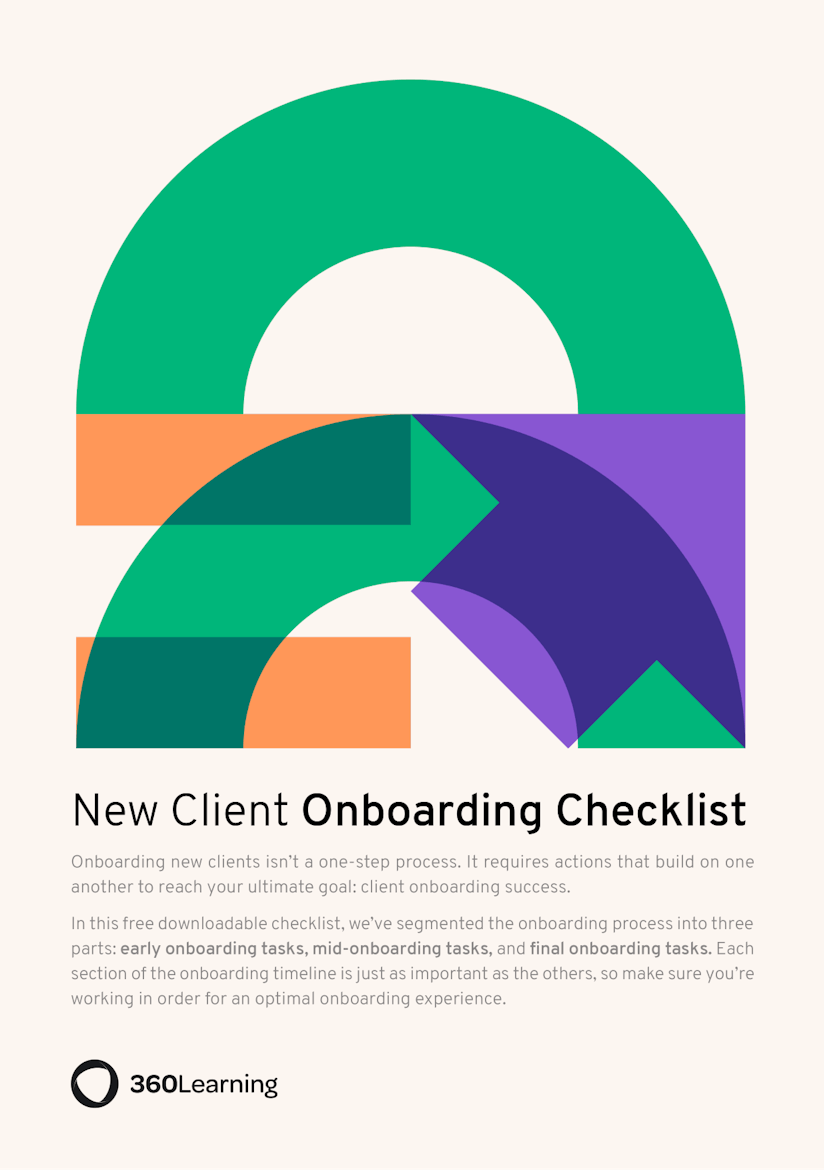
The client onboarding process may seem like just another task on the new client checklist, but it matters a lot—particularly in the SaaS world.
According to Wyzowl’s research, 88% of clients claim they’d likely stay brand loyal if a company has invested in welcoming and educational onboarding content.
Don’t miss out on new clients by forgetting onboarding. Follow these seven steps to show first-time clients why onboarding is so important and educate them about your product or service.
Ensure you never miss a critical client onboarding step with this free downloadable checklist.

Want to build better client relationships?
By providing your contact info, you agree to receive communications from 360Learning. You can opt-out at any time. For details, refer to our Privacy Policy.
What does it mean to onboard clients?
Onboarding clients is the process in which Client Support Managers (CSMs) provide new business partners with all the resources they need to work alongside the CSM’s team. You wouldn’t hire a new employee and then let them figure out the job alone, so why expect clients to do the same?
The most crucial element to discuss is your client’s onboarding strategy because it directly impacts their experience (and bottom line). So, let’s jump into our seven onboarding steps.
1. Research new clients’ needs
Before even meeting with your client in person, you and your team need to do some “pre-onboarding” work. Answering two main questions will help you narrow your focus with regard to initial client needs:
- What is your client’s business vision? Does your client have a mission statement about why their organisation exists? You need to know your client’s overall goal, the primary audience for their product or service, and the geographical area(s) your client serves.
- How does your client prefer to communicate? Keep in mind that “communication” can include your client’s choices about the proposal agreement, the contract, any deliverables you will owe them in the future, and any follow-up contacts. Some clients like weekly Zoom meetings; some like monthly calls—it all just depends on the client’s preference.
Along with answers to the questions above, make sure to gather all market, competitor, and client research, any ongoing process paperwork or online documents, website and social media information (and metrics), and any other client-specific data you’ll need to create a “brand bible” of sorts. This will serve as your one-stop resource for all client-related efforts.
2. Welcome new clients
Once you’ve worked out the details of your new client’s vision and contact preferences, it’s time for you to channel your inner host and send your client a warm welcome—because first impressions matter. In fact, it takes about 50 milliseconds (0.05 second) for visitors to form an opinion about your website. This means potential clients are using gut instincts and tiny fractions of time to make big business decisions, so your first interactions with them are especially important.
Your “welcome package” should include a welcome email that contains all the information and paperwork your client will need for your partnership. Consider sharing the following with your new client:
- A cheat sheet about your business that can include information like your company’s history, mission statement, a list of other clients, staff member bios, and more.
- Any homework you’d like your client to do—like gathering blog analytics data for the last year to help content agencies develop a marketing plan (if that’s part of their strategy).
- Case studies that demonstrate what your organisation has done for others in similar business verticals.
- A welcome video that puts faces to names. Introduce your client to the team members that will be working on their account. When clients were asked how they feel companies could improve their onboarding process, 69% of respondents said businesses should use more video, according to 2020 Wyzowl research.
Successful onboarding includes genuinely meeting, greeting, and beginning to get to know your new client. Get them up to speed on the state of your business, how it runs day to day, and your organisation’s expectations for them. Make sure to address any questions or concerns they may have.
3. Send a client onboarding questionnaire to determine desired outcomes
Before launching the onboarding process for a client, you and your team need to get a realistic view of where their business currently stands compared to where they want to be. One way your team can gain a better understanding of your client’s needs is by sending them an onboarding questionnaire.
Although some onboarding questions should be personalised for the client, here are 10 we find helpful, regardless of industry:
- Who are your preferred primary and secondary contacts or points of contact (POC) for this project and what is their preferred method of communication? Please provide any and all contact information for them.
- What is your business information? Please provide the following for your company:
undefinedundefinedundefinedundefinedundefined - Do you have any specialised software or analytics accounts we should have access to? Please provide any login credentials for these.
- What learning metrics do you have in place currently? These could include course completion rates, satisfaction rates, or the state of knowledge retention.
- If applicable: What are 10 keywords you want readers and visitors to associate with your company?
- How did you find our company, and why did you select us to help you with this project?
- What can our team do—whether it’s from a support perspective or otherwise—to help maintain a smooth, satisfactory onboarding process for you?
- What is the primary business problem you think we can help your company solve?
- Do you have a style guide? We need to know things like:
undefinedundefinedundefinedundefinedundefined - What is your definition of “success” with regard to this project?
You can deliver these questions over the phone or in a Zoom meeting if your clients prefer talking. Or you can send an email or an online form to complete if they’re more comfortable with that. However you choose to send these questions, make sure you include a deadline to get the answers back. A request like this shouldn’t take more than two business weeks unless other big issues arise.
If there were any unanswered sections in the client onboarding questionnaire, now is the time to gather that information, along with the client’s reasoning for leaving the question blank. Determining the reasoning can provide helpful insights into your client’s thought process. A blank question can mean they have an issue or difficulty with a specific aspect of the process—like the timeline, for example.
4. Schedule a kick-off call and set expectations
Whether your kick-off meeting is via a conference call, Zoom, or in person, it’s crucial to have a plan for your first official onboarding meeting. On the first kick-off call, you and your client should address the following actions and expectations:
- Introductions: Although your welcome video helped your client learn more about who they’ll be working with, you should re-introduce your team members and briefly explain their position in the company.
- Goals and expectations: Discuss their responses to the onboarding questionnaire, what your client wants to accomplish, and what you’ll need to help their organisation achieve these goals. Determine progress milestones and which key performance indicators (KPIs) you’ll use to gauge success.
- Deliverables and deadlines: Create a plan outlining important due dates and submission dates for campaign deliverables; determine action items for both parties.
When you’re setting expectations with clients, remember it’s always better to under promise and over deliver rather than the other way around.
5. Determine roles and responsibilities
Once pre-onboarding and discovery are complete, onboarding becomes more and more specialised for each team member, and roles on both sides become increasingly defined. Breaking down onboarding tasks into items for internal team members—and clients—to complete will help the process seem less daunting and more manageable.
At the end of this article, you’ll find a client onboarding process checklist your internal team can use as a resource to help you all work through the new client onboarding process.
During the early stages of onboarding, while your client’s employees gain experience performing role-specific tasks, you should provide continued learning opportunities via curated information housed within a collaborative learning platform. Tools like this make it easy to create, edit, and store onboarding checklists and information and other educational content that can help simplify the onboarding process.
6. Gather new client onboarding feedback and follow up
After you finish an onboarding experience, collect feedback from the client and internal team members. This input will help you smooth out any bumps in the onboarding process for future clients. One effective way to analyze individual performance feedback is with your learning management system’s (LMS) built-in tools. Admins can check progress reports and completion data by course, cohort, or learner.
The first thing you may be asking yourself is, “How do I know when I’m finished and ready to gather feedback”? It’s relatively simple: Did your client’s team successfully complete all the onboarding modules in your learning management system (LMS)? Do they understand their roles and objectives? Did you complete all the items on your onboarding checklist (download your free checklist here)? If you answered “yes” to these two questions, you’re ready for this step.
Check in with your client regularly using their preferred schedule and communication method. These check-ins can be casual—you’re there to help them with any onboarding issues they may have. You can just talk through the process thus far and keep things informal. Then you should perform a comprehensive check-in with your client after the first 30 days. Go over every step of the process. Any feedback they provide can be used to improve your onboarding process moving forward.
7. Remember the three Ps of a successful onboarding
To help you stay focused as you build client onboarding experiences, we’ve laid out three Ps for you to remember:
- Put people first: Seek to understand your client’s desires and aim to develop deep client relationships. Make sure building genuine trust is at the top of your onboarding to-do list. A few pointers for building trust:
undefinedundefinedundefinedundefined - Proactively prove your organisation’s value: Create a customised but flexible onboarding process that inspires confidence in your clients. Before they have to ask, provide additional learning materials for your busiest (or most curious) clients. Optimise your technical process and tackle any hardware or software issues right away to avoid hiccups or hold-ups.
- Practise organising communication: Set communication expectations during your kick-off call—let clients know what they can expect from your team. Exchange feedback regularly and document everything with the help of your LMS’s authoring tool. Elect a dedicated account manager for each client—this is the most important aspect of centralising your client management.
Take advantage of these tips to maximise your chances of client success and help your onboarding workflow run smoothly.
Effective onboarding starts (and ends) with collaboration
Client onboarding is about more than checking tasks off of a list (although that is part of it). Collaborative learning management systems like 360Learning also help L&D teams establish and implement the structure and consistency required to onboard clients effectively.
Because when it comes to onboarding, the more collaboration, the better. Both clients and staff should contribute to onboarding training by asking questions, sharing real-time feedback, and offering suggestions for course improvements.
We encourage you to treat these seven comprehensive steps as a template once you’re ready to onboard new clients. But if you’re seeking something highly specific—a pre-onboarding checklist for small business owners, for example—360Learning also has 16 more onboarding templates you can use for free for specific use cases, like small businesses and email.

Want to build better client relationships?
By providing your contact info, you agree to receive communications from 360Learning. You can opt-out at any time. For details, refer to our Privacy Policy.




